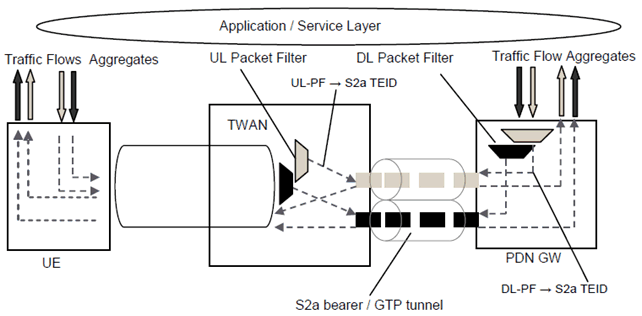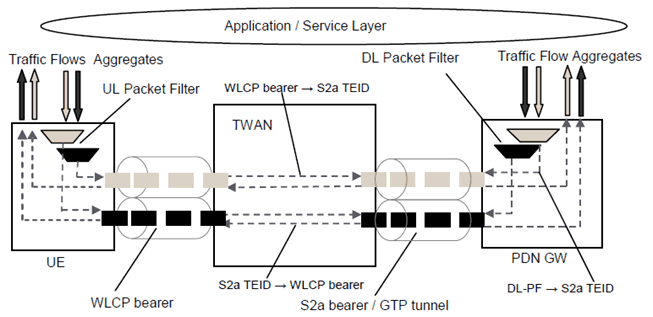Content for TS 23.402 Word version: 18.3.0
0…
4…
4.2…
4.2.2
4.2.3
4.3…
4.4…
4.5…
4.5.7…
4.6…
4.7…
4.7.2…
4.8…
4.8.2a…
4.9…
5…
5.2…
5.4…
5.5
5.6…
5.7…
5.8…
6…
6.2…
6.3
6.4…
6.4.3…
6.5…
6.6…
6.7…
6.8…
6.10…
6.13…
6.15…
7…
7.2…
7.3
7.4…
7.5…
7.6…
7.8…
7.10…
8…
8.2.1.2
8.2.1.3…
8.2.2
8.2.3…
8.2.6…
8.3…
8.4…
8.5…
9…
9.3…
9.4…
10…
13…
16…
16.1.2…
16.1.6…
16.2…
16.2.1a…
16.3…
16.4…
16.7…
16.8…
16.10…
17…
A…
C…
E…
16.1.6 Bearer model for PDN connectivity service with GTP based S2a
16.1.7 Access Network information reporting in case of a TWAN Access
...
...
16.1.6 Bearer model for PDN connectivity service with GTP based S2a p. 260
Two scenarios are supported. In one scenario, a single point-to-point connectivity between the UE and the TWAG is used to transport traffic for the default and all S2a bearer(s). This is described in clause 16.1.6.1. In the second scenario, a separate WLCP bearer is established for the default S2a bearer, and for each dedicated S2a bearer established on the S2a interface. This scenario applies when both the UE and the TWAN supports the establishment of multiple WLCP bearers. This is described in clause 16.1.6.2
16.1.6.1 Single point-to-point connection UE-TWAN |R15| p. 261

Figure 16.1.6.1-1: Two Unicast S2a bearers mapped in a single Point-to-Point connection (GTP based S2a)
(⇒ copy of original 3GPP image)
(⇒ copy of original 3GPP image)
For Trusted WLAN access to the EPC, the PDN connectivity service is provided by the point-to-point connectivity between the UE and the TWAG concatenated with S2a bearer(s) between the TWAG and the PDN-GW.
The bearer model of GTP based S2a interface is similar to that of GTP based S5/S8 interface and GTP based S2b interface. The TWAN handles the uplink packets based on the uplink packet filters in the TFTs received from the PDN-GW for the S2a bearers of the PDN connection, in the same way as an ePDG does for GTP based S2b interface.
16.1.6.2 Multiple point-to-point connection UE-TWAN |R15| p. 261

Figure 16.1.6.2-1: Two Unicast S2a bearers mapped to separate WLCP bearers (GTP based S2a)
(⇒ copy of original 3GPP image)
(⇒ copy of original 3GPP image)
This scenario applies when the UE and the TWAG support multiple WLCP bearers,
In this scenario, one default S2a bearer is established on the S2a interface when the UE connects to a PDN, and the default S2a bearer remains established throughout the lifetime of the PDN connection to provide the UE with always-on IP connectivity to that PDN. Additional dedicated S2a bearers may be established on S2a for the same PDN connection depending on operator policy. The PGW establishes dedicated S2a bearers on S2a for the same PDN connection based on PCC decisions as specified in TS 23.203.
The TWAG releases the WLCP PDN connection, when the default S2a bearer of the associated PDN connection is released.
The S2a bearer is realized with the following elements:
- A GTP tunnel on S2a transports the packets of an S2a bearer between the TWAG and a PDN-GW;
- The TWAG stores the mapping between WLCP bearer and the corresponding S2a bearer;
- The PDN-GW stores the mapping between downlink packet filters and an S2a bearer.
- for downlink packets, if the TWAG sets the DSCP, the TWAG may use the QCI, and optionally the ARP, in WLCP bearer level QoS information to derive the DSCP value for downlink packets.
- for uplink packets, the UE shall either use the DSCP value that it received from the TWAG, or the QCI in dedicated bearer QoS information to set the DSCP value for uplink packets. The mapping of QoS class to DSCP could be configurable in the UE and as an example can use the recommended mappings specified in 3GPP (mapping between standardized QCIs and Release 99 QoS parameter value in TS 23.401) and IEEE Std. 802.11-2012 [64]. The UE may also use information included in dedicated QoS information for local aspects of admission control (e.g. application traffic shaping) however this is out of scope for this document.
16.1.7 Access Network information reporting in case of a TWAN Access |R12| p. 262
In order for an Application Function (e.g. the P-CSCF) to be able to determine the NPLI (Network Provided location Information) of an UE in case of a TWAN access, the TWAN shall report over S2a TWAN related Access Network Information at PDN connection establishment, at bearer creation / modification / release and at PDN connection release. Such TWAN related Access Network Information may correspond to a "TWAN Identifier" and/or to a UE Time Zone.
The TWAN Identifier (reported over S2a, Gx, Gy, ...) shall include the SSID of the access point to which the UE is attached and shall include at least one of the following elements, unless otherwise determined by the TWAN operator's policies:
- the BSSID (see IEEE Std 802.11-2012 [64]);
- civic address information of the AP to which the UE is attached;
- line identifier (Logical Access ID see ETSI ES 282 004 [77]) of the access point to which the UE is attached.